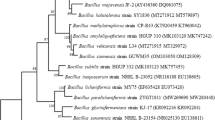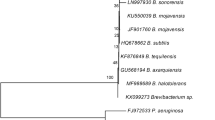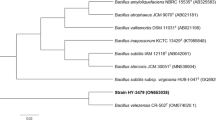Abstract
A Gram positive, rod-shaped potential strain was selected from the pool of bacterial isolates obtained from the Western Ghats forest (India) on the basis of zone of P-solubilization activity. Identification based on 16S rRNA gene sequence revealed that the strain is of Bacillus species, sharing highest sequence similarity to Bacillus tequilensis NRRL B-41771T (99.5%). Strain NII-0943 was able to produce good amount of indole acetic acid (IAA) and was positive for siderophore production. In addition to IAA and siderophore attributes, strain NII-0943 also possessed the characteristics like Ca3(PO4)2 solubilization and growth in nitrogen-free medium. Seed inoculation with the strain NII-0943 resulted in significantly higher root initiation in black pepper cuttings grown under pots. The contents of nitrogen and phosphorus in both soil and plant were also enhanced significantly in treatments inoculated with these bacterial inocula. Hence, based on this evidence it is proposed that strain NII-0943 could be deployed as a plant growth-promoting inoculant to attain the desired results of bacterization.
Similar content being viewed by others
Abbreviations
- CAS:
-
chrome Azurol-S
- IAA:
-
indole acetic acid
- NA:
-
nutrient agar
- NBRIP broth:
-
National Botanical Research Institute’s phosphate growth medium
- PGPB:
-
plant growth-promoting bacteria
References
Ahmad F., Ahmad I. & Khan M.S. 2008. Screening of free-living rhizospheric bacteria for their multiple plant growth-promoting activities. Microbiol. Res. 163: 173–181.
Altschul S.F., Gish W., Miller W., Myers E.W. & Lipman D.J. 1990. Basic local alignment search tool. J. Mol. Biol. 215: 403–410.
Arshad M. & Frankenberger W.T. 1991. Microbial production of plant hormones. Plant Soil. 133: 1–8.
Bakker A.W. & Schipper B. 1987. Microbial cyanide production in the rhizosphere in relation to potato yield reduction and Pseudomonas spp. mediated plant growth stimulation. Soil Biol. Biochem. 19: 451–457.
Bashan Y. & Holguin G. 1997. Azospirillum/plant relationships: environmental and physiological advances (1990–1996). Can. J. Microbiol. 43: 103–121.
Baudoin E., Nazaret S., Mougel C., Ranjard L. & Moenne-Loccoz Y. 2009. Impact of inoculation with the phytostimulatory PGPR Azospirillum lipoferum CRT1 on the genetic structure of the rhizobacterial community of field-grown maize. Soil Biol. Biochem. 41: 409–413.
Benson D.A., Karsch-Mizrachi I., Lipman D.J., Ostell J. & Sayers E.W. 2010. GenBank. Nucleic Acids Res. 38: D46–D51.
Berleth T. & Sachs T. 2001. Plant morphogenesis: long-distance coordination and local patterning. Curr. Opin. Plant Biol. 4: 57–62.
Biari A., Gholami A. & Rahmani H.A. 2008. Growth promotion and enhanced nutrient uptake of maize (Zea mays L.) by application of plant growth promoting rhizobacteria in Arid region of Iran. J. Biol. Sci. 8: 1015–1020.
Costacurta A. & Vanderleyden J. 1995. Synthesis of phytohormones by plant-associated bacteria. Crit. Rev. Microbiol. 21: 1–18.
Cross A.F. & Schlesinger W.H. 1995. A literature review and evaluation of the Hedley fractionation: applications to the biogeochemical cycle of soil phosphorus in natural ecosystems. Geoderma 64: l97–214.
Diby P. & Sarma Y.R. 2006. Antagonistic effects of metabolites of Pseudomonas fluorescens strains on the different growth phases of Phytophthora capsici, foot rot pathogen of black pepper (Piper nigrum L.). Arch. Phytopathol. Plant Protect. 39: 113–118.
Dobbelaere S., Croonenborghs A., Thys A., Vande Broek A. & Vanderleyden J. 1999. Phytostimulatory effect of Azospirillum brasilense wild type and mutant strains altered in IAA production on wheat. Plant Soil 212: 155–64
El-Tarabily K.A. 2004. Suppression of Rhizoctonia solani diseases of sugar beet by antagonistic and plant growth-promoting yeasts. J. Appl. Microbiol. 96: 69–75.
Frankenberger W.T., Jr. & Poth M. 1987. Biosynthesis of indole-3-acetic acid by the pine ectomycorrhizal fungus Pisolithus tinctorius. Appl. Environ. Microbiol. 53: 2908–2913.
George C. K., Abdullah A. & Chapman K. 2005. Pepper Production Guide for Asia and the Pacific. Joint effort of the International Pepper Community (IPC) and Food and Agricultural Organization of United Nations (FAO). Bangkok, Thailand, IPC, ISBN-979-99118-0-X.
Glick B.R. 2005. Modulation of plant ethylene levels by the enzyme ACC deaminase. FEMS Microbiol. Lett. 251: 1–7.
Glick B.R., Penrose D.M. & Li J. 1998. A model for the lowering of plant ethylene concentrations by plant growth-promoting bacteria. J. Theor. Biol. 190: 63–68.
Gordon A.S. & Weber R.P. 1951. Colorimetric estimation of indole acetic acid. Plant Physiol. 26: 192–195.
Idris E.E., Iglesias D.J, Talon M. & Borriss R. 2007. Tryptophandependent production of indole-3-acetic acid (IAA) affects level of plant growth promotion by Bacillus amyloliquefaciens FZB42. Mol. Plant Microbe Inter. 20: 619–626.
Jeffries P., Gianinazzi S., Perotto S., Turnau K. & Barea J.J.M. 2003. The contribution of arbuscular mycorrhizal fungi in sustainable maintenance of plant health and soil fertility. Biol. Fertil. Soils 37: 1–16.
Jukes T.H. & Cantor C.R. 1969. Evolution of protein molecules, pp. 21–132. In: Munro H.N. (ed.) Mammalian Protein Metabolism, vol 3. Academic Press, New York.
Kaldorf M. & Ludwig-Muller J. 2000. AM fungi might affect the root morphology of maize by increasing indole-3-butyric acid biosynthesis. Physiol. Plant. 109: 58–67.
Khalid A., Arshad M. & Zahir Z.A. 2004. Screening plant growth promoting rhizobacteria for improving growth and yield of wheat. J. Appl. Microbiol. 96: 473–480.
Kimura M. 1980. A simple method for estimating evolutionary rates of base substitutions through comparative studies of nucleotide sequences. J. Mol. Evol. 16: 111–120.
Kumar S., Tamura K. & Nei M. 2004. MEGA3: integrated software or molecular evolutionary genetics analysis and sequence alignment. Brief. Bioinform. 5: 150–163.
Lambrecht M., Okon Y., Vande Broek A. & Vanderleyden J. 2000. Indole-3-acetic acid: a reciprocal signalling molecule in bacteria-plant interactions. Trends Microbiol. 8: 298–300.
Lanyi B. 1987. Classical and rapid identification methods for medically important bacteria. Methods Microbiol. 19: 1–67.
Le Floch G., Rey P., Benizri E., Benhamou N. & Tirilly Y. 2003. The impact of auxin compounds produced by the antagonistic oomycete, Pythium oligandrum or the minor pathogen, Pythium group F on plant growth. Plant Soil 257: 459–470.
Marmur J. 1962. A procedure for the isolation of deoxyribonucleic acid from microorganisms. J. Mol. Biol. 3: 208–218.
Miller J.M. & Rhoden D.L. 1991. Preliminary evaluation of Biolog, a carbon source utilization method for bacterial identification. J. Clin. Microbiol. 29: 1143–1147.
Murphy J.P. & Riley J.P. 1962. A modified single solution method for the determination of the phosphate in natural waters. Anal. Chim. Acta 27: 31–36.
Nautiyal C.S. 1999. An efficient microbiological growth medium for screening phosphate solubilizing microorganisms. FEMS Microbiol. Lett. 170: 265–270.
Park M., Kin C., Yang J., Lee H., Shin W., Kim S. & Sa T. 2005. Isolation and characterization of diazotrophic growth promoting bacteria from rhizosphere of agricultural crops of Korea. Microbiol. Res. 160: 127–133.
Pikovskaya R.I. 1948. Mobilization of phosphorus in soil connection with the vital activity of some microbial species. Mikrobiologiya 17: 362–370.
Saitou N. & Nei M. 1987. The neighbor-joining method: a new method for reconstructing phylogenetic trees. Mol. Biol. Evol. 4: 406–425.
Sarma Y.R. 2003. Global scenario of disease and pest management in black pepper. Int. Pepper News Bull. Ju–Dec 2003: 69–74.
Schwyn B. & Neilands J.B. 1987. Universal chemical assay for the detection and determination of siderophore. Anal. Biochem. 160: 47–56.
Thompson J.D., Gibson T.J., Plewniak F., Jeanmougin F. & Higgins D.G. 1997. The CLUSTAL_X windows interface: flexible strategies for multiple sequence alignment aided by quality analysis tools. Nucleic Acids Res. 25: 4876–4882.
Tsavkelova E.A., Cherdyntseva T.A. & Netrusov A.I. 2005. Auxin production by bacteria associated with orchid roots. Mikrobiologiya 74: 55–62.
Xie H., Pasternak J.J. & Glick B.R. 1996. Isolation and characterization of mutants of the plant growth-promoting rhizobacterium Pseudomonas putida GR12-2 that overproduce indole acetic acid. Curr. Microbiol. 32: 67–71.
Author information
Authors and Affiliations
Corresponding author
Additional information
These authors contributed equally to the work
Rights and permissions
About this article
Cite this article
Dastager, S.G., Deepa, C.K. & Pandey, A. Growth enhancement of black pepper (Piper nigrum) by a newly isolated Bacillus tequilensis NII-0943. Biologia 66, 801–806 (2011). https://doi.org/10.2478/s11756-011-0105-3
Received:
Accepted:
Published:
Issue Date:
DOI: https://doi.org/10.2478/s11756-011-0105-3




